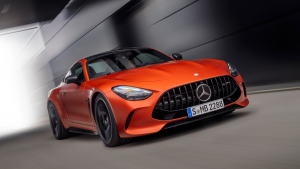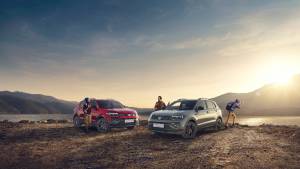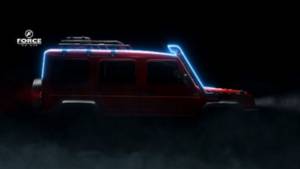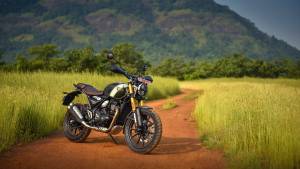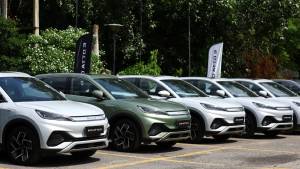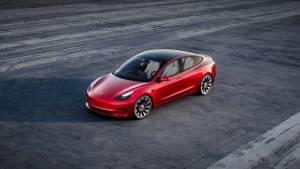Golden jubilee
Team OD
Published: August 25, 2011, 11:10 PM IST
The Jaguar E-Type may be the most famous car in the world. It was the poster car when your father and grandfather were young, before Lamborghinis, Paganis and the Bugatti Veyron even existed: simply the most gorgeous, most glamorous car of its era.
The E-Type made in its debut at the Geneva Motor Show in 1961. In the days before instant electronic communication, all important new cars were unveiled at motor shows. There were no car launches like today, with detailed engineering briefings and extensive driving routes for journalists, primed in advance with preview releases or spy photos.
William Lyons, the founder and chairman of Jaguar Cars, sent an engraved invitation card to a small number of motoring writers to attend a press conference at the Restaurant des Eaux Vives, in a park overlooking Lake Geneva, at 4.30 in the afternoon on the eve of the show's opening. By all accounts, this was not much more than a photo-call and an opportunity to chat to William Lyons and Bill Heynes, Jaguar's chief engineer, but immediately afterwards and during the show, journalists and prospective customers were given the opportunity to experience the car on a short route in the hills behind the restaurant.
This year, to celebrate the 50th anniversary of this event, Jaguar went back to the Eaux Vives with a troop of 20 E-Types and a lucky few, the successors to those senior motoring correspondents, received e-mail invitations to a re-enactment of the car's introduction.
Appropriately, Ratan Tata was there and took a ride in 77RW, the original open E-Type demonstrator, with Tata Motors chief executive Carl-Peter Foster at the wheel. The journos present had the pick of the delicious selection to take over the 8km route used for the test drives in 1961.
Fifty years ago, the hills south of the lake were crossed by empty country roads; today, those roads are lined with residences. So what was then a white-knuckle ride with a Jaguar driver in one of the fastest cars in the world had to be re-run at a much gentler pace. But, in another sign of the times, we drove ourselves; in 1961, Jaguar wouldn't trust their new baby to a bunch of newspaper men.
One of Jaguar's drivers at the original event was Norman Dewis, now 90 years old and as bright and enthusiastic as ever. As Jaguar's chief test driver, he had particular reason to remember the E-Type launch. He was testing another prototype at the MIRA proving ground in England when he received a call from William Lyons commanding him to drive immediately to Geneva.
Realising the sensation that the E-Type had created on the first day of the show, Lyons needed a second demonstrator at the Eaux Vives. Dewis climbed into 77RW in Coventry at 7.45 in the evening and drove the 1,100km to Geneva in 14 hours, including the ferry crossing the English Channel. His on-the-road average was 109kmph â" at a time when there were scarcely any motorways.

The E-Type was billed as a 150mph (240kmph) car and this maximum speed was verified by independent tests. Only later did it emerge that the designated pre-production test car had a specially tuned competition engine and other tweaks not shared with cars delivered to customers. Still, they were quick enough to leave everyone impressed â" 0-100kmph in 7 seconds and 0-160kmph in 16 seconds was record acceleration for a production road car in 1961.
The E-Type remains impressive today. The car that wowed them on the show stand at Geneva in 1961 was a coupe and it was a similar car â" actually a 1963 Series 1 coupe â" that I took out on the hill-climb course. Bright red with a tan interior, this car is part of the Jaguar Heritage collection.
My previous experience of E-Types was with the 1970s V12-engined model, and by comparison the original was a revelation: it is smaller, much lighter and feels lithe and athletic. The 3.8-litre straight-six engine is strong and sweet. It develops 268PS, purrs like a Jaguar should, and is torquey enough to allow the car to trickle through traffic in high gear at not much more than idle speed. That's probably just as well, because the four-speed Moss gearbox is notorious as the first E-Type's worst feature; it has no synchromesh on first gear and from rest the lever is more eager to slot into reverse than the first gear position alongside. I had been told that the (unassisted) steering is heavy, the driving position uncomfortable and that the brakes require a lot of effort for not much result. At speeds restrained by what are now essentially suburban roads, I had no problem with any of those things. It was a nice surprise that the car's structure felt so stiff â" no shakes, rattles or groans â" and that it rode over bumps and rough surfaces with the calmness of a luxury saloon. No modern sports car with similar power and performance offers such ride comfort. Of course, this and the manageable steering come about because of the narrow wire wheels and tyres and they can't provide the road-holding and sheer grip of today's equipment. And, although this car has seat belts, E-Types of this era had nothing much in the way of safety equipment or crash protection. What they did have was wonderful visual appeal. A bright red E-Type, even at the age of 50, still turns the heads of passers-by, and for the driver there is something particularly exciting about sitting low down behind that long, louvered bonnet, stroking the large wood-rimmed steering wheel.
Between 1961 and 1974, 72,500 E-Types were made, so this is not the rarest of cars. Jaguar misjudged its successor, the XJ-S, and never again re-captured the spirit, character or the sheer beauty of the original E-Type.
Today's Jaguar was wise not to present the new XKR-S - its 2011 Geneva debutant and the fastest production Jaguar ever made â" as the natural successor to the E-Type.
I reminded Ratan Tata that when Tata acquired Jaguar Land Rover he expressed the hope that Jaguar would produce a new model like the E-Type. He replied that he still hankered after such a car and cited the Porsche 911 as an example of how to keep an iconic design of the 1960s fresh and relevant. "But we have a new sports car design and it is not like that," he said with evident regret. However much the ultimate boss likes the idea of a retro car along the lines of the E-Type it is the management of JLR that has to decide whether such a model could be built and represent good business.
The engineers and designers point out that it is not possible to meet today's safety regulations in a car with the lithe lines and perfectly balanced proportions of the first E-Type. And after variations on the same Jaguar saloon shape, design director Ian Callum is determined to set and new and more aggressive style for the marque in the 21st century: the XF and latest XJ show that direction.
Carl-Peter Forster and Ralph Speth, Jaguar Land Rover CEO, have both acquired â" and enjoy â" early E-Types but they don't want to build a new one. Forster said: "We love Jaguar's heritage but society has changed in 50 years and we must build cars that cater for today's requirements."
Speth sought to reassure us: "Of course we are working on an authentic Jaguar sports car." Will that be the successor to the E-Type? His reply: "Please, notâ¦"
So we should savour this half century celebration of a great car. For just a few hours in Geneva, the clock was turned back and the E-Type was new again - the star of the show.
Price (Ex-Delhi)
Starts Rs 12 Crore
Starts Rs 12 Crore
Displacement
7993cc
7993cc
Transmission
Automatic
Automatic
Max Power(ps)
1001
1001
Max Torque(Nm)
1250
1250
Mileage
4.02 Kmpl
4.02 Kmpl
Price (Ex-Delhi)
Starts Rs 1.38 Crore
Starts Rs 1.38 Crore
Displacement
2998cc
2998cc
Transmission
Automatic
Automatic
Max Power(ps)
350
350
Max Torque(Nm)
530
530
Mileage
-NA-
-NA-
Related Stories
Top Stories
Latest Videos
Most Popular
- Budget Sportbike Showdown: Kawasaki Ninja 500 vs Aprilia RS 457 vs Yamaha YZF-R3
- Mumbai-Pune Expressway speed restrictions updated
- 2014 Triumph Daytona 675 vs 2024 Kawasaki ZX6R - A Decade of Evolution in Supersport Motorcycles
- 2024 Hyundai Creta vs Toyota Urban Cruiser Hyryder vs Skoda Kushaq comparison review - the hype is real?
- Nissan Magnite EZ-Shift review - is the AMT any good?
Network18 Updates
Compare

